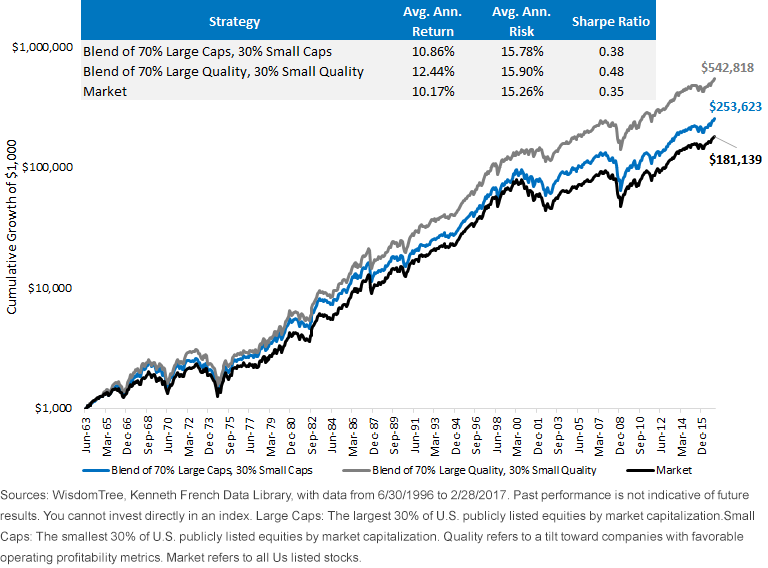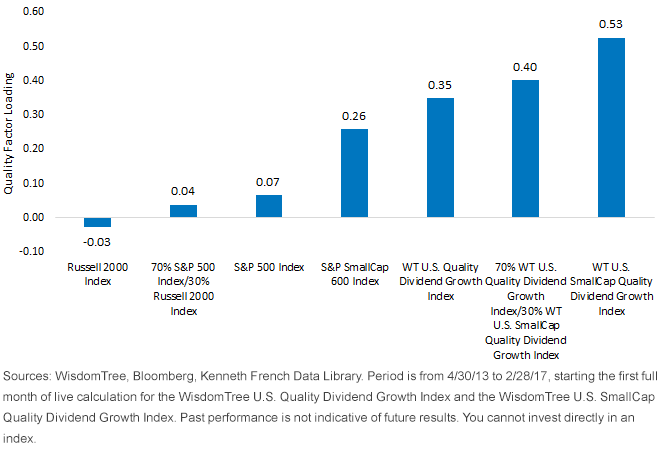How to Build a More Complete Quality Portfolio in U.S. Equities


In 2015, Cliff Asness and his colleagues released a paper with the highly provocative title “Size Matters, if You Control Your Junk.”1
We agree that taking an additional layer of focus within small-cap stocks—for example, small caps plus quality, small caps plus value or small caps plus momentum—can be very helpful, to allow for the risk/return trade-offs to be potentially more attractive.
However, it is critical to think of small caps not only as stand-alone options but also in terms of how they might sit within portfolio allocations.
Quantifying a Quality Upgrade over the Long Term

Large Caps and Small Caps vs. Large Quality and Small Quality
Factor investing has generated significant attention of late:
- Blending Large Caps and Small Caps Outperformed the Market: Over this very long period, going from a full, broad market strategy to a strategy of 70% large caps and 30% small caps outperformed by more than 60 basis points (bps) per year. However, this did also come with an incremental increase in about 60 bps of risk, leading to a slightly higher Sharpe ratio.
- Practical Application of the Factor Discussion—the “Quality Upgrade”: Much has been made of the various investment factors, but we think one of the primary potential benefits lies in introducing tilts to a given exposure. Here, we looked at the concept of 70% large-cap quality and 30% small-cap quality, instead of merely saying 70% large cap and 30% small cap. As can be seen, there was a greater than 2%-per-year incremental increase in returns, leading to a terminal growth of $1,000 that is more than twice as high as simply looking at the large-cap/small-cap blend alone. This was also achieved with a much more significant increase in the Sharpe ratio.
Small Caps Offer Fertile Ground for Factor Tilts
While the five commonly discussed factor exposures are value, momentum, quality, size and low volatility, we’d encourage investors to not think of them as necessarily being mutually exclusive. For instance, the concept of small value has been prevalent for many years and would imply exposure to at least two factor premiums—small caps and value.
The real bottom line is that factor tilts within small caps afford the opportunity to challenge the traditional assumption that one needs an active manager to outperform in the “less efficient” small-cap space.
How WisdomTree Provides Small-Cap Quality Exposure
One other investment strategy often utilized focuses on the power of dividend growth over the long haul. We associate dividend growth strategies with the traditional quality factor from the academic world.
Although the first place many might look for dividend growth within U.S. equities is large-cap, blue-chip companies, many might be surprised to learn that the phenomenon can also be captured within U.S. small caps. In 2013, we developed the WisdomTree U.S. SmallCap Quality Dividend Growth Index, which zeros in on U.S. small-cap companies with the potential to grow their dividends over time. An important point: we use a forward-looking methodology as opposed to past dividend history to avoid narrowing the Index. For example, as of March 31, 20172:
- The S&P 500 Dividend Aristocrats Index requires constituents to exhibit at least 25 years of consecutive, year-over-year dividend growth, and it had 51 member stocks as of this date. The broader S&P High Yield Dividend Aristocrats Index, which requires a mere 20 years of consecutive dividend growth, had 108 members.
- The S&P MidCap 400 Dividend Aristocrats Index requires constituents to exhibit at least 15 years of consecutive, year-over-year dividend growth, leading to 46 member stocks as of this date.
Do you think it’s impossible to focus solely on small caps while encompassing an attentiveness to dividend growth? The WisdomTree U.S. SmallCap Quality Dividend Growth Index had 257 constituents as of March 31, 2017.3 The reason for the relative broadness of exposure is that the forward-looking earnings growth expectations combined with return on equity and return on assets create a logical framework upon which potential future dividend growth may be built.
Accessing the Quality Factor in Recent Years

- Factor Lading: There are a few crucial comparisons to point out. First, there’s the stepwise progression from the Russell 2000 Index (which has negative loading to quality) to the S&P SmallCap 600 Index (constituents are required to demonstrate profitability prior to initial inclusion) to the WisdomTree U.S. SmallCap Quality Dividend Growth Index, which had about twice the loading to quality as the S&P SmallCap 600 Index. Second, there is the stepwise progression from the S&P 500 Index to the WisdomTree U.S. Quality Dividend Growth Index on the large-cap side, with about five times the quality loading as the S&P 500 Index.
- Blends Exhibited Significant Differentiation: The blend of 70% S&P 500 Index/30% Russell 2000 Index had a .04 loading to quality, whereas the blend of 70% WisdomTree U.S. Quality Dividend Growth Index/30% WisdomTree U.S. SmallCap Quality Dividend Growth Index had a loading to quality of .40, 10 times higher.
As we discussed in this piece on the long-term returns to various small cap indexes, there can be a wide differentiation in returns to small-cap factor strategies. If one is looking for exposure to the “small-cap quality” factor, we find little competition for the WisdomTree U.S. SmallCap Quality Dividend Growth Index, certainly few with as high of a factor loading to it. Over the long run, we believe this factor will be rewarded, and this WisdomTree Index is unique in capturing this concept.
1Source: Chris Asness et al., “Size Matters, if You Control Your Junk,” AQR, 1/15 (first draft).
2Respective index fact sheets with data as of 3/31/17 for the S&P 500 Dividend Aristocrats Index, the S&P High Yield Dividend Aristocrats Index and the S&P MidCap 400 Dividend Aristocrats Index.
3Sources: WisdomTree, FactSet.
Important Risks Related to this Article
Dividends are not guaranteed, and a company currently paying dividends may cease paying dividends at any time.Investments focusing on certain sectors and/or smaller companies increase their vulnerability to any single economic or regulatory development.

Christopher Gannatti began at WisdomTree as a Research Analyst in December 2010, working directly with Jeremy Schwartz, CFA®, Director of Research. In January of 2014, he was promoted to Associate Director of Research where he was responsible to lead different groups of analysts and strategists within the broader Research team at WisdomTree. In February of 2018, Christopher was promoted to Head of Research, Europe, where he was based out of WisdomTree’s London office and was responsible for the full WisdomTree research effort within the European market, as well as supporting the UCITs platform globally. In November 2021, Christopher was promoted to Global Head of Research, now responsible for numerous communications on investment strategy globally, particularly in the thematic equity space. Christopher came to WisdomTree from Lord Abbett, where he worked for four and a half years as a Regional Consultant. He received his MBA in Quantitative Finance, Accounting, and Economics from NYU’s Stern School of Business in 2010, and he received his bachelor’s degree from Colgate University in Economics in 2006. Christopher is a holder of the Chartered Financial Analyst Designation.

